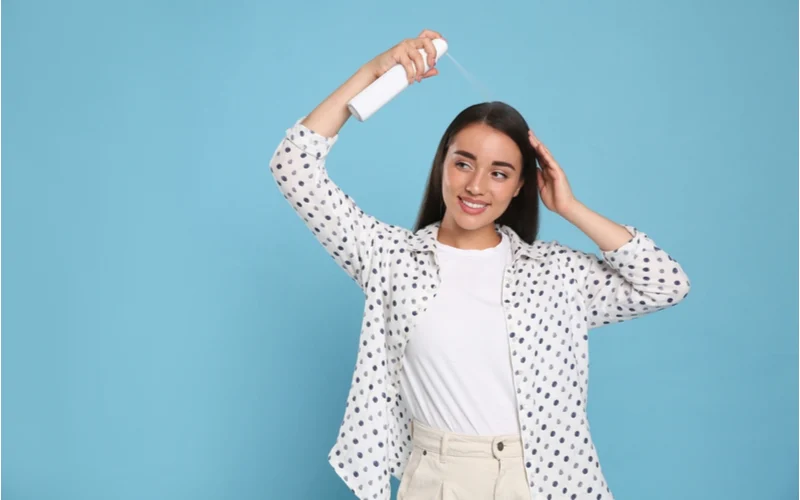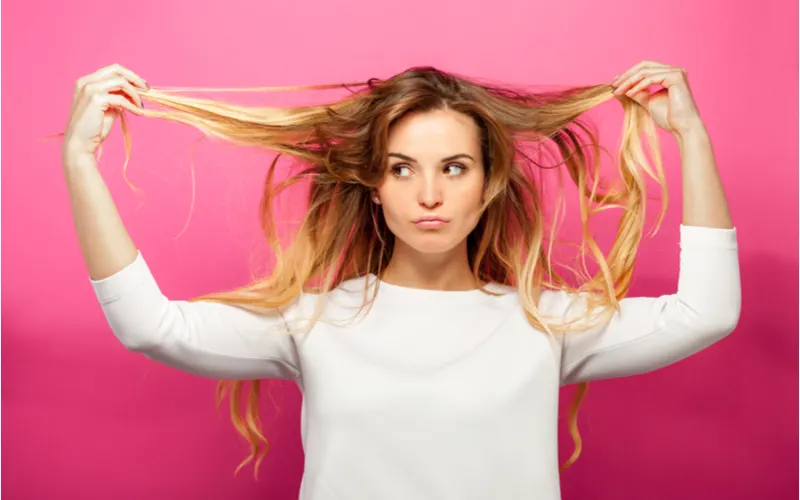Jump to:
With recalls like Proctor and Gamble taking their aerosol dry shampoo off the market, it might have you thinking, “what can I use instead of dry shampoo?” Many dry shampoo alternatives exist, and we’ll share the top 10 below.
What Can I Use Instead of Dry Shampoo?
Dry shampoo is a product to remove oil from hair without showering, and items like corn starch, perfume, and paper towels can serve as a replacement. In this article, we’ll walk you through the following:
- History of dry shampoo
- Benefits and disadvantages
- Best dry shampoo alternatives
Whether you run out of dry shampoo or want to use a natural product, there’s no need to walk around with an embarrassing head of greasy hair. Read on to learn about the many solutions for dry shampoo alternatives.
Read Next: When to Use Dry Shampoo and How to Use Dry Shampoo
What the Heck Is Dry Shampoo?

New Africa/Shutterstock
Dry shampoo has a history of transforming a greasy head of hair into a state that people can be proud of without having to step into the shower. It has many benefits, but like so many things, there are some downsides you’ll need to be aware of, too.
History of Dry Shampoo
Dry shampoo got its start in the 1940s when Stephanie Brooke Company created the first-ever dry shampoo, called Minipoo. During that time, marketers targeted women who were sick and unable to shower, promising to whisk away the excess oils in their hair.
Minipoo became popular, given that people didn’t have to worry about soap getting into their young children’s eyes, and it protected wavy hair.
It came with a disposable mitt for application. Nowadays, most dry shampoo products allow people to spray the product directly into their hair, using their hands to spread it, if needed.
Benefits of Dry Shampoo
People can enjoy numerous benefits by using dry shampoo, given that it offers convenience for greasy hair touch-ups on the go or when you don’t have access to a shower.
Some of the biggest benefits include:
- You can skip washing your hair for a few days longer than usual
- Preserves the natural oils in hair
- You’ll save time getting ready
- Swells hair strands to offer a voluminous appearance
- Reduces color fade due to less traditional shampooing
Dry shampoo also makes it easier to form messy buns, braids, and other updo hairstyles, especially if you have thin, fine hair. Dry shampoos come in a range of attractive smells, and they’ll also absorb any not-so-pleasant smells emanating from your hair.
Finally, it offers benefits for people with disabilities who have trouble getting into and out of the bathroom.
It also reduces the amount of time lifting your hands over your head compared to traditional apply-and-rinse shampoo, meaning that people with limited arm mobility can remain more independent.
Disadvantages of Dry Shampoo
Despite the many benefits of using dry shampoo, there are a few important items to keep in mind before using it.
Some downsides to using dry shampoo include:
- It can clog hair follicles
- Hair breakage can happen
- You won’t have a clean head of hair
The bottom line is that dry shampoo covers up a dirty head of hair. For this reason, it’s a popular option to use on occasion or in emergency touch-up situations, should you struggle with oily hair.
Furthermore, using dry shampoo won’t prevent the oil build-up that happens from frequent friction between your hair and skin.
The 10 Best Dry Shampoo Alternatives
You came here because of the question, “What can I use instead of dry shampoo?” We won’t keep you waiting any longer. Below are our top choices.
1. Cornstarch
That’s right—a trip to your kitchen is all it takes to create an alternative dry shampoo. If you have grey, blonde, or other light-colored hair, you can apply cornstarch directly to your hair.
For darker hair, stir some cocoa powder or cinnamon in the cornstarch before applying, according to the color that most closely matches your hair. Try pouring cornstarch in a salt or pepper shaker and tapping it over your head to make the application easier.
2. Baby Powder
Baby powder is all about absorption, which is why it makes for a great dry shampoo. As with cornstarch, you can try adding some cocoa or cinnamon powder to change its color. However, baby powder has a strong, white color.
So, if you aren’t already rocking light-colored grey hair, you’ll need to take extra care in ensuring you don’t overapply. Otherwise, you could end up aging yourself or having to shower it off if you overdo it.
3. Apple Cider Vinegar
It might seem strange to see liquid as a replacement for dry shampoo, but it works, we swear! To use apple cider vinegar as a dry shampoo, mix one drop of vinegar per ounce of water in a spray bottle.
Then, aim the spray bottle at your roots and go to town with spraying. The trick for this method is preparing in advance, as you’ll need to wait for the apple cider vinegar and water solution to dry before seeing the results.
In addition to not leaving behind a physical powder or residue like so many of the dry shampoo alternatives on this list, vinegar also contains healthy tonic properties for the scalp.
Read Next: What Is an Apple Cider Vinegar Hair Rinse?
4. Hand Sanitizer
We’re back at it again with liquids. You likely know the sensation of hand sanitizer landing in your palms wet before quickly drying. The same phenomenon happens to your scalp, so it’s a faster solution than apple cider vinegar if you need to “shampoo” your hair quickly.
Another advantage of hand sanitizer is that it blends in flawlessly with any hair color. That said, hand sanitizer isn’t the best option if you already struggle with dandruff or a sensitive scalp.
5. Setting Powder
Makeup setting powder can help you avoid the chalky texture that sometimes crops up when using corn starch or baby powder. And, just as with your face, this powder does an excellent job of soaking oil on your scalp and roots to keep your hair looking shower fresh.
The best way to use makeup setting powder on your hair is by using a makeup brush. Of course, you’ll want to ensure you’re using a clean one—you don’t want to spread oils from your hair onto your face!
6. Blotting Papers
If you’re not in love with the thought of leaving a product in your hair, blotting papers are an excellent dry shampoo-like option. Just as these papers can soak up oil around your face, they do a beautiful job of getting rid of oil in your hair.
When using blotting papers, use clips to part your hair in different sections. Then, gently rub the paper over your roots. As you can imagine, you’ll likely need to use more blotting papers on your scalp than you do on your face.
7. Paper Towels
If you’re in a real bind, you can use paper towels instead of blotting paper. Ideally, paper towels that specialize in having ultra-absorbent properties are best.
Follow the same procedure as blotting papers by dividing your hair into sections before gently whisking away excess oil with the paper towel.
8. Salt and Cornmeal
If you want to up your cornmeal dry shampoo game up a notch, try adding salt. The coarse nature of salt makes it great for bouncing along your scalp, encouraging the cornmeal to maximize its ability to soak up oil.
Should you choose to add salt to your cornmeal, we recommend doing so in the ratio of one tablespoon of salt pre ½ cup of cornmeal. Then, use a hairbrush to encourage the salt and cornmeal to loosen up and remove the oil and dirt in your hair.
Brushing your hair after applying salt will also help get this mixture out of your scalp. Otherwise, if you let it sit there for too long, the salt could irritate or dry out sensitive skin.
9. Perfume
As with hand sanitizer, perfume tackles an oily scalp by using its alcohol content to dry out the roots of your hair. In fact, the alcohol has properties to break down oil, causing a fast and notable reduction in how greasy your hair looks.
Using perfume on your hair as dry shampoo is a breeze, given that perfume is in a dry shampoo-ready bottle. Simply hold it 2 – 3 inches from your roots and spray it onto your hair.
Alternatively, you can spray perfume onto a brush and comb it through your hair, focusing on the hair closest to your scalp. Nevertheless, you’ll need to be fast for this to work, so using a combination of these methods is often the most effective.
10. Dry Clay
Dry clay makes an excellent shampoo because its absorbent properties make it a magnet to oil. The reason for its fast-acting nature is silica, which physically removes grease from hair. You can pick from a range of dry clay, all of which come with a unique fragrance.
Examples include agar and powdered orris root. However, dry clay can cause your hair to lose some of its suppleness, so we recommend mixing it with some milk powder.
Frequently Asked Questions

Leszek Glasner/Shutterstock
If you’re still wondering, “What can I use instead of dry shampoo?” and the mechanisms behind how dry shampoo works, we’ve got answers for you.
How do I make my hair look less greasy without dry shampoo?
To make your hair look less greasy without dry shampoo, try putting some cornstarch, hand sanitizer, or blotting paper on it. You can also try hiding greasy hair with braids or a headband.
Can I use baby wipes on my hair?
You can use baby wipes on your hair, although they might push around the oil on your hair rather than soak it up. So, baby wipes are more effective for taming frizzy hair.
Does drinking water help oily hair?
Increasing your water intake may help manage oily hair over time by keeping your scalp and hair more hydrated. However, if you want a fast fix for treating oily hair, using dry shampoo or an alternative is your best bet.
What is wet dandruff?
Wet dandruff is dandruff that accumulates oil. Normally, dandruff is white. However, oil buildup causes it to turn a yellowish color.
Why is my hair so oily after one day?
Hair that becomes oily after one day is often the result of shampooing your hair too frequently. Doing so strips natural oils from your scalp. So, your body may react by producing an excess of oil.
So, What Can I Use Instead of Dry Shampoo?
Dry shampoo is a product that absorbs oil to make your hair appear shower fresh. Many products make excellent dry shampoo alternatives, including corn starch, hand sanitizer, and blotting papers. Using these items will save you time and keep you looking your best when you’re on the go.
